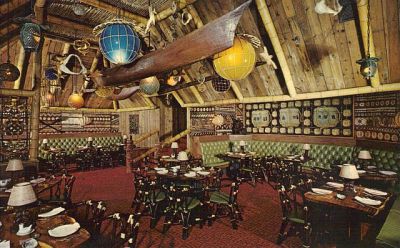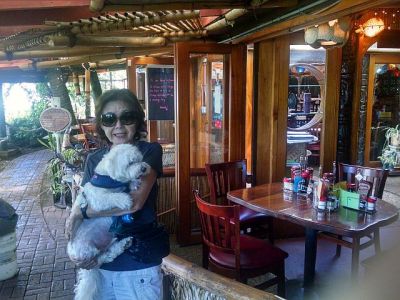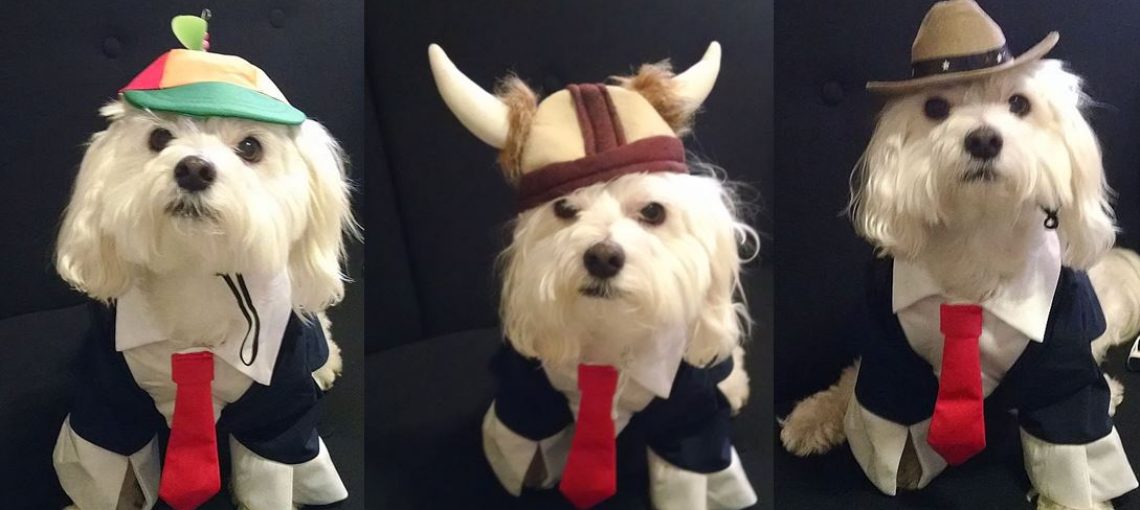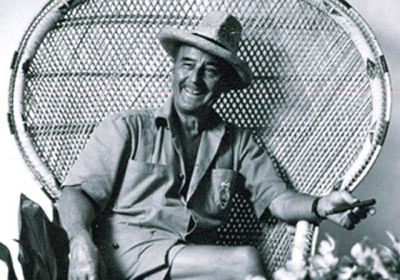
Stop me if you heard the joke: a Malt and the Alpha Japanese Female (AJF) walk into the last Tiki bar…
The Tiki Bar dates back to 1933 when a guy by the name of Ernie Gantt opened his first “Don the Beachcomber” restaurant in Los Angeles. It was a place stuffed full of faux-Polynesian statuary and artifacts with a menu focused on exotic rum drinks and Chinese food re-named to pretend that it came from genuine Pacific Island recipes.
At one time Tiki bars were the hottest trend. Today, they are a relic of the America landscape in the years just before and after World War 2.
This story is about the last Tiki bar in Honolulu. Max, the AJF and I are fond of this place and we often visit when picking up or dropping off friends and relations at the airport. Arrive and hit the Tiki bar. Depart and hit the Tiki bar. It’s a nice symmetry but I digress.
Ernie Gantt started out as a bootlegger from Texas who moved to California during Prohibition and went totally Hollywood, establishing what was considered an outlandish food and beverage concept themed to the South Seas.
This was prime escapist fare for celebrities of the time like David Niven and Marlene Dietrich. The restaurants were considered a bit raffish with uncertain reputations – in 1936 Howard Hughes partied late at a Tiki bar and then struck and killed a pedestrian with his car while driving home.
Keep in mind that the Pacific Islands, Oceania and Southeast Asia were terra incognita for Americans in pre-World War 2. To folks back then, the Tiki establishments were as exotic as the cantina scene in Star Wars.

The interior of a Trader Vic’s Tiki Bar & Restaurant. This one was in Boston I believe. Not my photo.
The Don the Beachcomber restaurant chain grew to 16 facilities, mostly due to the efforts of Ernie’s wife.
She was the driving force that perpetuated the Don the Beachcomber brand during WW2 in which Ernie served with distinction, earning a Purple Heart and Bronze Star, while following orders from his friend General Jimmy Doolittle to set up rest and relaxation camps for the Air Force along the French Riviera.
Tiki culture flourished in post-war America. Tiki restaurants were perhaps the top fad in the 1940s and 50s. During that period, Don the Beachcomber faced stiff competition from the larger, copy cat Trader Vic chain and the owners of these Tiki restaurants became amicable rivals for life. Both Ernie Gantt and Vic Bergeron claimed to have created the Mai Tai which is perhaps the most famous of the rum drinks. The Zombie was another drink of contested origin.

Max and the AJF outside the restaurant part of La Mariana Sailing Club, the last Tiki bar in Honolulu.
Ernie got so wrapped up in his own myth and legend that he formally changed his name several times from Donn Beach-Comber, to Donn Beachcomber, and finally Donn Beach.
When Don divorced his wife and business partner Sunny, she retained control over the restaurants and Don was prohibited from opening a Don the Beachcomber in the United States.
In response, he moved to Hawaii (which had not yet become a State), settled in Waikiki, and opened a venture called the “Polynesian Village.” Inside the bar was a mynah bird that presided over the premises and was trained to yell, “Give me a beer, stupid!”
Don’s faux-Polynesian operation launched the careers of many entertainers, notably the giants of the “exotica” music genre, Arthur Lyman and Martin Denny. Exotica music blended the sounds of conga, bongos, vibes, Indonesian and Burmese gongs, bamboo sticks and Japanese koto along with bird calls, big-cat roars, and even primate shrieks to invoke the dangers of the jungle. Fantasy music taken to a whole new level. Here, take a listen.
Over his career, Don invented 84 bar drinks to embellish his Tiki concept. He remained a well known figure in Honolulu until he died in 1989 at the age of 81.
The Tiki culture lasted longer than most other fads. At one time, Honolulu was plastered (hehe – bad pun) with bars decorated with carved fake gods, thatched roofs, tree stump stools, velvet paintings and the infamous pu-pu plate which offered such creatively Polynesian nibbles as egg rolls, sweet and sour ribs and pineapple-shrimp kebabs, all washed down with huge rum drinks.

No self-respecting Tiki bar would lack a Tiki Hut, source of fine souvenirs with a special focus on ashtrays made from faux-lava and hollow bamboo drink glasses! It was closed so the Malt could not pay a visit.
Little known facts:
1) Rum was chosen as the Tiki bar liquor of choice, not because of any affiliation with island culture, but because it was the cheapest alcohol available in the post-Prohibition days.
2) “Tiki” derives from the Tahitian language. In Hawaii the god statues are called ki’i and, quite frankly, the Tiki theme is insulting to some native Hawaiians because they feel it mocks their religious beliefs. Sort of the equivalent of a Jesus Bar or Mohammed Lounge. Most folks roll with the notion that the whole Tiki thing was just a fantasy promotion dreamed up by rascally Ernie to flog booze but be aware that others are offended by the whole idea.
Tiki culture has made a stab at recovery from time to time but the successors are what the Aussies might call “weak beer.” Even now there are several of these so-called Tiki bars in Honolulu but there is only one true inheritor of the Don the Beachcomber mantle.
Honolulu’s last Tiki bar is located in an industrial district on Ke’ehi Lagoon, not far from the end of the Honolulu International Airport runway. It’s not easy to find and its name is rather bland: La Mariana Sailing Club.
Founded in 1957, it has survived almost six decades, two moves, assorted financial crises and tidal waves. The last tidal wave, following Japan’s March 2011 earthquake, damaged boats at the adjacent docks, but La Mariana soldiered on. The story of this establishment and its revered female founder is worth a read – find the fascinating tale of Annette La Mariana Nahinu here.
And now here’s a delightfully cheesy promotional video made by the last Tiki bar that explains more about the place than I could veer hope to accomplish:
This bar and restaurant has an extensive collection of artifacts gathered from other Tiki bars upon their closing including the old carved statues from the Sheraton Hotel’s Kon Tiki Room, the koa wood tables from Don The Beachcomber, stuff from Trader Vic’s, the Tahitian lanai and other legendary watering holes of Eisenhower-era Waikiki.

The last Tiki bar is across the lagoon from the seaplane runways which, of course, are water. You can book a flight over Honolulu from there for about $150 for a half hour.
This is where you come to drink rum in tall glasses with little umbrellas, pineapple garnish and abnormal coloring.
Things like a Mai Tai, a Zombie, a Hurricane, a Tropical Itch or the Blue Hawaii. It is always 1957 at the La Mariana Sailing Club.
The décor is classic Tiki bar: tapa-print tablecloths, shell chandeliers, carved statues, canoes, lighted glass fishing floats suspended in nets and lots of candles and string lights.
The food is basic bar food with an emphasis on quantity at a reasonable price. For $20, you can accompany your libation with a large platter of tako (octopus) and ahi (tuna) poke and decent sashimi or a massive rib plate or a wide variety of fried seafood delights.

La Mariana is also an actual sailing club. This is a snapshot of the harbor taken from the front door of the Tiki bar.
The entertainment at La Mariana is well worth making a visit. There is a blind piano player who is very talented and quite well known among bar folk. The over-60 set claims karaoke privileges on weekend evenings and it’s not unusual to have some locally famous names and faces join in singing the old songs.
“Drunken family fun” is a fair description of the late night ambiance. The family-style ambiance asserts itself with the staff’s attitude, too. Just like family they feel free to hug you, insult you, ignore you, dote on you and enfold you depending on their mood and your behavior.
At the end of the evening, everyone stands up, forms a circle and holds hands, and sings Hawaii Aloha, (listen to one of my favorite versions by Braddah Iz, here) the state anthem Hawaii Pono’i, and, usually, America the Beautiful. Often, an ancient standard like My Maile Lei gets thrown in for good measure.

Step right in, order a rum drink or four, nibble some raw fish and bask in all that Tiki memorabilia.
Chances are, if you visit me I‘ll end up taking you to La Mariana. I find it’s a bit of a litmus test for a person’s adaptability to island life, a strange blend of fantasy, campy culture from a bygone day and a mélange of interesting characters, not all of whom live in the present. I have found that if you cannot handle the scene, you may be wound a bit too tightly for our laid back lifestyle.
La Mariana Sailing Club. The last real Tiki bar in Honolulu.
LATE ADDITION:
I was asked for more info about the song Hawaii Aloha that I linked in this story. It is revered as a local anthem and twice – in 1967 and 1978 – almost became the official state anthem. We sing this song at the conclusion of most all gatherings, formal and informal. You can be at a public meeting, fighting like cats and dogs, but when the first notes are struck, everybody stands, forms a circle, joins hands and sings together. Traditionally, you raise your joined hands above your head for the last chorus. I happen to love this song and what it represents.
If you didn’t click on the link above, here’s another chance; it’s a lovely melody and watch how the song galvanizes everyone to join together. Here are the words and the meaning:
E Hawaiʻi e kuʻu one hānau e
Kuʻu home kulaīwi nei
ʻOli nō au i nā pono lani ou
E Hawaiʻi, aloha ē
O Hawaiʻi, O sands of my birth
My native home
I rejoice in the blessings of heaven
O Hawaiʻi, aloha.
E hauʻoli e nā ʻōpio o Hawaiʻi nei
ʻOli ē! ʻOli ē!
Mai nā aheahe makani e pā mai nei
Mau ke aloha, no Hawaiʻi
Happy youth of Hawaiʻi
Rejoice! Rejoice!
Gentle breezes blow
Love always for Hawaiʻi.
E haʻi mai kou mau kini lani e
Kou mau kupa aloha, e Hawaiʻi
Nā mea ʻōlino kamahaʻo no luna mai
E Hawaiʻi aloha ē
May your divine throngs speak
Your loving people, O Hawaiʻi
The holy light from above
O Hawaiʻi, aloha.
Nā ke Akua e mālama mai iā ʻoe
Kou mau kualono aloha nei
Kou mau kahawai ʻōlinolino mau
Kou mau māla pua nani ē
God protects you
Your beloved ridges
Your ever glistening streams
Your beautiful flower gardens.
Categories: Max's Stories



Well, I’m in. There’s no part of that video I didn’t like. The views are gorgeous, the interior is every campy thing that makes me happy, the Tiki glasses for the drinks are perfect, drunken families, singing and holding hands with strangers, perpetually 1957? I don’t know why you’d ever leave. I would work there just to get paid to be there and then at the end of my shift, I’d sit at the bar. Does Max get his own chair?
LikeLiked by 1 person
Max is restricted to the small lanai (patio) that abuts the bar but he gets a good view of the goings on and is very popular especially with the oldsters who greet him on arrival and then get progressively more loving as the Zombies kick in. There was a time when this old style aloha was common in Waikiki and across the islands but it has become very rare in the far more commercialized and branded version of Hawaii that is now offered to visitors.
I’m pretty sure you would enjoy a night at the Tiki bar, Kerbey. You’d probably join us at the piano and hum the parts when you don’t know the Hawaiian words and the waitresses, all old enough to be your Mom, would fawn over you and bring you snacks. Later we’d all roll out and watch the night skies over the harbor and see what the night fishermen caught.
LikeLiked by 1 person
We have to do that.
LikeLike
Trader Vic’s? Talk about a blast from the past! As long as they will still serve my drink with an umbrella, I’m in.
LikeLiked by 1 person
Yup, umbrellas abound at the bar. You should see them mix the rum drinks – they “free hand” it and often keep pouring the hootch long after any sane bartender would have put down the bottle. Our son often reminds us of a visit where he ordered one Zombie and almost had to be carried out of the place.
LikeLiked by 1 person
I have to visit…I don’t know the words but can hum to perfection as long as the bartender keeps pouring.
Translate rum to whisky in its multifarious forms and I knew bars where singing O’Donell Abhu and the Sean Van Voght was mandatory…but I doubt that they have survived…the bars, that is, as the customers had a habit of setting fire to the bar on the weekends..
LikeLiked by 1 person
“Oh! the French are on the sea,
Says the Sean van Voght,
“The French are in the Bay,
They’ll be here at break of day,
And the Orange will decay.”
‘Fessin up, I had to turn to Doctor Google to get your musical references. I suspect those Irish bars took their singing far more seriously than La Mariana devotees. Irish songs are often about the struggles and fighting whilst most Hawaiian songs (not all) are more gentle. Both can be good for drinking but the outcome with the Hawaiian song may be easier on one’s nose and knuckles.
LikeLike
Oh, and I’m informed the song title is actually Sèan bhèan bhòcht for those pedantic b*stards amongst us. 🙂
LikeLike
For those who pretend to practice the Erse…
LikeLike
O the French are in the bay says the Sean Van Voght
ditto
If the French are in the bay then we all will have our way
And the Orange will decay says the Sean Van Voght
And what shall we do then says the Sean Van Voght
ditto
We’ll repair to yonder dyke and we’ll sharpen our great pike
And the Orange will away says the Sean Van Voght
And what will the yeoman do says the Sean Van Voght
ditto
They’ll throw off their red and blue and to liberty prove true
And they’ll chase the Orange away says the Sean Van Voght.
O’Donell Abhu was nearly the national anthem….
Oh dear, I feel a Celtic moment coming upon me…bring on the Three Swallows of Johnny Powers…
LikeLike
OK, stupid, where’s that damn beer I ordered?
LikeLiked by 1 person
Kismet, you’re just jealous that a lowly mynah bird got all the glory. And the beer.
LikeLike
Buddy the Maltese Dog, say Hi Max! You can count me in too, just as long as I can have my very own chair that swings and great view along with a rum and coke I’ll be in my doggy glories.
LikeLiked by 1 person
A chair swing and an adult beverage don’t seem too much too ask so consider yourself included! The views are free and gorgeous.
LikeLiked by 1 person
Thank you Max, I’m all for relaxing!
LikeLike
Great post Tom and Max you watch out for those bars. Sounds like you’ll become a pup of dubious repute. I will have to revisit this post when I get a sound card sorted. My laptop died and is awaiting Mr IT Guru’s attention (ie Geoff). xx Rowena
LikeLike
Exotic rum drinks?! Yes, please. 😉 The only sounds I really need to hear is a refreshing fizz sound and ocean waves. Ahhhhh. Oh yes and nom, nom, nom. on the sashimi. 😉
Love the ambiance of that place-what a terrific review with historical info (as always). I’ll be sending my itinerary soon. 😉
LikeLike